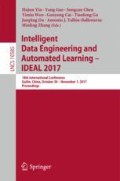Abstract
Prediction of remaining useful life (RUL) has widely application in industrial domain, especially for aircraft where safety and reliability are of high importance. RUL Prediction can provide the time of failure for a degrading system, so that there are high requirements of its accuracy. In this paper, we propose a new trajectory similarity-based RUL prediction approach with an information fusion strategy (named IF-TSBP) in the similarity measure step. The novel information fusion strategy allows us to get more precise trajectory similarity degree than traditional similarity measure strategy which contributes to the prediction result. The experimental results show that the prediction accuracy of our proposed algorithm IF-TSBP outperforms the traditional trajectory similarity-based prediction approach and some common machine learning algorithms.
Access this chapter
Tax calculation will be finalised at checkout
Purchases are for personal use only
References
Wang, T., Yu, J., Siegel, D., et al.: A similarity-based prognostics approach for remaining useful life estimation of engineered systems. In: International Conference on Prognostics and Health Management, PHM 2008, pp. 1–6. IEEE (2008)
Khelif, R., Malinowski, S., Chebel-Morello, B., et al.: RUL prediction based on a new similarity-instance based approach. In: 2014 IEEE 23rd International Symposium on Industrial Electronics (ISIE), pp. 2463–2468. IEEE (2014)
Lam, J., Sankararaman, S., Stewart, B.: Enhanced trajectory based similarity prediction with uncertainty quantification. In: PHM 2014 (2014)
Benkedjouh, T., Medjaher, K., Zerhouni, N., et al.: Remaining useful life estimation based on nonlinear feature reduction and support vector regression. Eng. Appl. Artif. Intell. 26(7), 1751–1760 (2013)
Saxena, A., Goebel, K., Simon, D., et al.: Damage propagation modeling for aircraft engine run-to-failure simulation. In: International Conference on Prognostics and Health Management, PHM 2008, pp. 1–9. IEEE (2008)
Sateesh Babu, G., Zhao, P., Li, X.-L.: Deep convolutional neural network based regression approach for estimation of remaining useful life. In: Navathe, S.B., Wu, W., Shekhar, S., Du, X., Wang, X.S., Xiong, H. (eds.) DASFAA 2016, Part I. LNCS, vol. 9642, pp. 214–228. Springer, Cham (2016). doi:10.1007/978-3-319-32025-0_14
Acknowledgments
The research work is supported by National Natural Science Foundation of China (U1433116), and the Fundamental Research Funds for the Central Universities (NP2017208) and Foundation of Graduate Innovation Center in NUAA (kfjj20171603).
Author information
Authors and Affiliations
Corresponding author
Editor information
Editors and Affiliations
Rights and permissions
Copyright information
© 2017 Springer International Publishing AG
About this paper
Cite this paper
Wang, Z., Tang, W., Pi, D. (2017). Trajectory Similarity-Based Prediction with Information Fusion for Remaining Useful Life. In: Yin, H., et al. Intelligent Data Engineering and Automated Learning – IDEAL 2017. IDEAL 2017. Lecture Notes in Computer Science(), vol 10585. Springer, Cham. https://doi.org/10.1007/978-3-319-68935-7_30
Download citation
DOI: https://doi.org/10.1007/978-3-319-68935-7_30
Published:
Publisher Name: Springer, Cham
Print ISBN: 978-3-319-68934-0
Online ISBN: 978-3-319-68935-7
eBook Packages: Computer ScienceComputer Science (R0)

